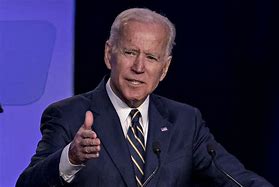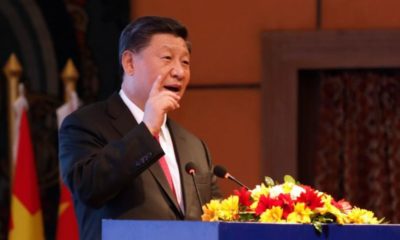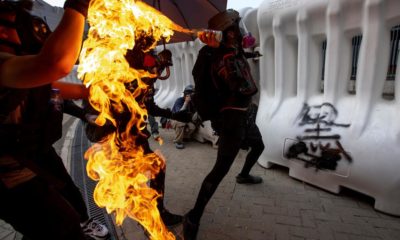World
China unveils action plan on Silk Belt, Road initiative

Beijing: China unveiled on Saturday the principles, framework, and cooperation priorities and mechanisms in its Silk Belt and Road initiative in a bid to enhance regional connectivity and embrace a brighter future together, as per reported.
The vision and action on jointly building the Silk Road Economic Belt and 21st-Century Maritime Silk Road, an initiative raised by Chinese President Xi Jinping during visits to Central Asia and Southeast Asia in 2013, was issued by China’s top economic planner, the National Development and Reform Commission and the ministries of foreign affairs and commerce.
The initiative aims to promote orderly and free flow of economic factors, highly efficient allocation of resources and deep integration of markets by enhancing connectivity of Asian, European and African continents and their adjacent seas.
It is open to all countries and international and regional organisations for engagement and honours mutual respect and market operation to seek common prosperity, the plan said.
“The programmes of development will be open and inclusive, not exclusive. They will be a real chorus comprising all countries along the routes, not a solo for China itself,” Chinese President Xi Jinping said on Saturday while addressing the opening ceremony of the 2015 annual conference of the Boao Forum for Asia (BFA) in the coastal town of China’s southernmost island province of Hainan.
The initiative is not meant as rhetoric. It represents real work that could be seen and felt to bring real benefits to countries in the region, Xi added.
The plan called for policy coordination, facilities connectivity, unimpeded trade, financial integration and people-to-people bonds to make complementary use of participating countries’ unique resource advantages through multilateral mechanisms and multilevel platforms.
China will fully leverage the comparative advantages of its various regions and further open up for more interaction and cooperation both at home and internationally.
The development of the Belt and Road initiative is a pluralistic and open process of cooperation which can be highly flexible without sticking to conformity, according to the plan.
China is ready to work with participating countries in improving the content and mode of the initiative and developing timetables and roadmaps of cooperative mechanisms, plans and projects, the plan added.
The action plan came three days ahead of the deadline of the application for joining the Asian Infrastructure Investment Bank (AIIB), a China-initiated lender to offer financing for regional infrastructure projects.
Russian First Deputy Prime Minister Igor Shuvalov said at the Boao forum on Saturday that Russia decided to join the AIIB. Up to now 39 countries both from the developed and developing regions have applied to be prospective founding members of the AIIB.
Xi said China welcomed all countries along the routes and in Asia, as well as friends and partners around the world to take an active part in these endeavours.
In promoting this initiative, China would follow the principle of wide consultation, joint contribution and shared benefits, Xi said.
World
Lockdowns in China Force Urban Communities to Defy Censorship and Vent Frustration Online

Shanghai’s rich middle class is leading a wave of online dissent over the strict and prolonged lockdowns imposed in various parts of the country. Chinese internet censorship is struggling as patience is wearing thin in many urban centers, coming up with creative forms of online protests.
Social Media Posts Revealing Lockdown Tension in Shanghai
Drawn-out lockdowns are nothing new in China as authorities insist with the nation’s zero-Covid policy since the start of the pandemic. Currently over This time around, however, metropolitan areas like Shanghai are increasingly difficult to keep quiet, given that its more than 25 million residents have seen weeks of total isolation along with food shortages and many other service interruptions.
Dozens of towns and reportedly over 300 million Chinese citizens have been affected by lockdowns of different severity. As expected, urban netizens have been most outspoken over their difficulties by finding creative ways to get around state censorship and bans placed on topics, news comments and spontaneous campaigns.
Shanghai residents have been using mobile proxies and hijacking seemingly unrelated hashtags to talk about healthcare issues, delivery failures and the overall severity of their situation. The “positive energy” that the Chinese government wants to transmit during the recent prolonged series of lockdowns does not come naturally to those counting food supplies and online censors are working hard to filter words, trending topics and undesired social media sharing.
WeChat groups and message threads are under constant monitoring. Posts questioning the zero-Covid approach have been quickly deleted, including by leading Chinese health experts like Dr. Zhong Nanshan. Video footage is soon censored and protests and investigations are quickly made to disappear.
Where this has not worked, officials have exposed banners with warnings and outright threats like “watch your own mouth or face punishment”, while drones have been patrolling the city skies. Yet, if anything, this has led to further tensions and unspoken confrontation with Shanghai’s educated and affluent middle class.
Creative Online Solutions Harnessing Civic Energy
Announcements by Chinese social media that they would be publishing the IP addresses of users who “spread rumors” have not helped either. Tech industry research has shown that much of Asia’s tech-savvy population has a habit of using mobile proxies and other privacy tools, quickly finding workarounds to browse the internet freely and talk to the world about the hottest topics.
The sheer volume of forbidden posts is already a challenge for the very censorship system, experts explain. Unable to track all trending hashtags, state workers overlook topics that speak about the US, Ukraine or other popular news. Linking human rights elsewhere to their situation, Chinese online dissidents establish their informal channels and “hijack” the conversation to share personal or publicly relevant information about the Covid suppression in their town.
Sarcastic and satirical posts still dominate. Others hope to evade the censors by replacing words from famous poems or the national anthem. One thing is certain – social media, when harnessed with the right creativity, has proven its ability to mount pressure on the government in even some of the most strictly controlled tech environments like China.























